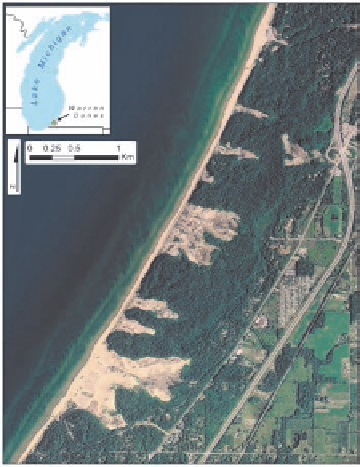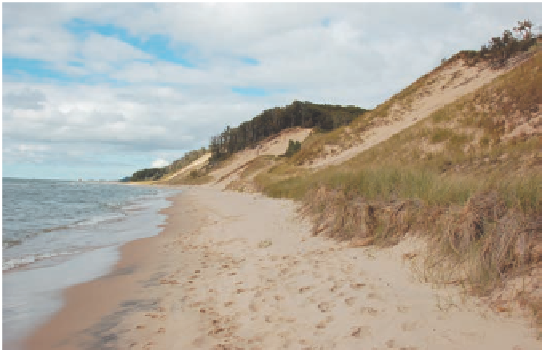Geoscience Reference
In-Depth Information
D I S C O V E R . . .
COASTAL dUNES ALONG THE EASTERN SHORE
Of LAKE MICHIGAN
Although coastal dunes are typically associated with marine en-
vironments, some of the most impressive dune fields in North
America occur along the many shores of the Great Lakes in
Wisconsin, Michigan, and Ontario, Canada. Of these freshwa-
ter dune systems, perhaps the best are the fantastic dune fields
that line much of the eastern shore of Lake Michigan, ranging
from northern Indiana to the northern end of Lower Michigan.
These dune fields contain a variety of foredunes (see Figure
19.25a) and are often large transgressive systems with numer-
ous parabolic dunes embedded within them. An air photo from
Warren Dunes along the southeastern shore of Lake Michigan
nicely shows an example of these landfroms. Some of these
parabolic dunes are up to 60 m (~195 ft) high and contain
enormous quantities of sand. Along the northwestern shore of
Lower Michigan, dune fields often mantle high bluffs and are
thus called
perched dunes
. These landscapes collectively are
some of the most beautiful in the Midwest, if not the country.
Aside from their scenic character, I am particularly attract-
ed to Lake Michigan coastal dunes because I am a geomor-
phologist and study them in my own research. Earth scientists
have long known that the eastern shore of Lake Michigan is a
perfect place for the development of large coastal dune fields
for three reasons: (1) prevailing westerly winds blow across the
lake, (2) Lake Michigan has a long fetch, which means that the
air flows cleanly across the lake before it strikes the shore, and
(3) sand supply is very high from deposits left behind by Pleis-
tocene glaciations. Working with some excellent colleagues,
my research focuses on the history of sand mobilization and
dune growth as it relates to climate change and fluctuations
in the level of Lake Michigan over time. With a variety of dat-
ing techniques, we have been able to show that the dunes
began to form about 5000 years ago in many places and have
grown in distinct stages since that time. These periods of dune
growth seem to have most often occurred when the lake was
rising, which apparently pushed sand on to the beach where it
could be blown by the wind inland. These findings are impor-
tant for environmental management in Michigan because the
dune landscapes are heavily utilized for real estate develop-
ment and sand mining. In addition, about 3 million people a
year visit the numerous scenic parks, such as Warren Dunes,
that are scattered along the coast. If you have a chance to visit
them someday, I highly recommend it because they rival many
of the coastal dune systems anywhere else in the world!
Aerial image of Warren Dunes State Park along the southeast-
ern shore of Lake Michigan. Note the big parabolic dunes and
blowouts that dominate the park. The orientation of the dunes
indicates the prevailing winds are westerly, although some dunes
were shaped by southwesterly winds.
View of dunes along the southeastern shore of Lake Michigan
from the beach. Lake Michigan is to the left (west). Dunes like this
line much of the shore in this part of Michigan and are up to 60 m
(195 ft) high.






